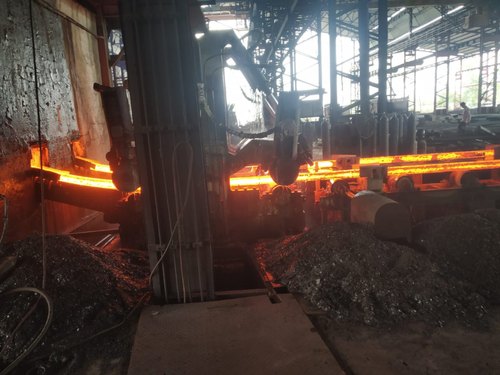The Continuous Casting Machine / Billet Casting Machine / Concast Machine is an equipment to convert liquid steel into cast semis of the desired size.
The main equipments of this machine are :
• Ladle stand for holding the ladle in the casting position.
• Tundish (acts as a liquid steel distributor to strands)
• Tundish Car (for housing of tundish)
• Mould Jacket Assemblies
• Mould Oscillator
• Strand Guide frames
• Withdrawal-cum-straightening machine
• Electricals / Instrumentation etc.
Molten Steel from the furnace is spilled at accurate temperature into the Ladle and the Ladle Slide Gate is opened to enable the liquid metal to slide into the Tundish, which then allows it to the mould assembly through a refractory nozzle. A tundish car is provided to transport the tundish to the Casting Station. Steel stream from the tundish is taken through the mould assembly which houses the curved copper mould tube to give the required shape of the section being cast.
The mould serves as a container during the initial formation of the strand and the rapid circulation of cooling water produces a shell around the molten core enabling the strand to withstand the ferrostatic pressure after it leaves the mould. The strand is withdrawn with the help of the dummy bar.
The surface of the mould is lubricated to minimize any sticking of the molten metal to the copper mould. This lubrication is accomplished with rapeseed oil.
Mould oscillation mechanism is used for oscillating the mould so that the newly formed strand shell does not stick to the mould wall.
A cooling water system supplies water under pressure to the mould and to the spray chamber and discharge tables. The water cools the molten metal in the mould and further solidifies the strand in the spray apron during the casting process. Water is also used to cool the equipment.
The strand guide assembly provides the support for the billet strand between the mould and the Straightener assembly. It also forms a support for the cooling water pipe work. Curvature of the billet is maintained throughout its passage along the strand guide.
A Straightener assembly mounted at CCM level provides the drive for withdrawal & straightening for each of the hot strands. It also provides the drive for the dummy bar for its insertion in Mould during start of the cast.
The discharge section of the machine consists of a pre-cut off roller table, cutting area, discharge roller table and cooling beds.
A Dummy Bar Assembly housed in a Storage Device / Receiver Assembly provides the means of withdrawing the strand from the mould at the start of casting.
Cutting of the strand into billets is effected with manual / auto gas cutting torches.
The cut billets are transported along the discharge table until they contact the end stops. The pusher mechanism then moves the billets across the roller table onto the cooling beds.
A Hydraulic Power Pack provides the pressure to operate the Straightener, Pusher and Dummy Bar Receiver cylinders.
Control of the discharge sequence is from the discharge control desk mounted on a platform in the discharge area.
In the discharge area, two ventilated rooms are located one below the other for electrical and hydraulic controls. The multi-motor control centre is positioned on the top floor and hydraulic power pack on the ground floor.



